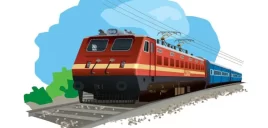Multiple signals may be mounted on a signal assembly (bracket post, signal gantry, etc.) to provide signal indications for diverging routes. The signals from left to right correspond to the diverging routes from left to right. If one of the routes is the main line, the signal for it is usually placed higher than the others (the maximum permissible speed applies for running through on it; speeds must be lowered for the divergences).
For instance, a very common combination is for three stop signals to be mounted together, with the middle one being placed higher and providing the indication for the main route, whereas the signals on the left and right of it provide indications for the branches on either side. If all routes are of equal importance, all signals are at the same height. (‘Equal importance’ in practice means all the routes allow the maximum permissible speed for the section.)
ये भी पढ़े – योगासन का इतिहास तथा योग से होने वाले फायदे
In rare circumstances, one can find multiple signals placed on the same mast one above the other; in such a case, the convention is that the highest one refers to the leftmost divergence, and successive signals below it refer to successive routes to the right.
The same convention applies for converging routes (top-to-bottom is left-to-right). Although diverging routes can share a single signal (with a route indicator in colour-light signalling), converging routes never share signals; a separate signal is provided for each line.
For colour-light signals, a junction route indicator or directional type route indicator is commonly used to indicate diverging routes. This consists of an additional set of 5 lunar white lamps in a row at an angle, attached to the main signal. The angle of the junction route indicator corresponds in a rough manner to the angle made by the diverging route. When these additional lamps are lit, they indicate that the signal applies to a diverging route. Otherwise, the signal is taken to apply to the main route.
More than one junction route indicator may be attached to a signal, in the case of facing points where more than two routes diverge, although it is rare to see more than 3 or 4 such indicators (6 is the maximum). The junction route indicator corresponds to a ‘feather’ in UK railway terminology. Junction route indicators are used where the number of diverging routes is smaller and where high visibility is a requirement.
In some cases, especially for home signals at stations that have many platforms, or at routing signals guarding approach to a lot of diverging routes, a theatre route indicator may be provided. This usually indicates the route (or road as it is sometimes termed) with a numeric display. The numerals may be formed using a 7×5 dot-matrix lamp assembly (the multi-lamp route indicator, MLRI), or with lamps lit behind stencils indicating route numbers (the stencil type route indicator, STRI).
There are also projector type route indicators which project the numeral on to an illuminated screen or plate. For all of these, a route indication is always provided, even for the main line, in contrast to the directional route indicators which remain unlit for the main line.
For a signal guarding departure from a station, a theatre route indicator may rarely have ‘M’ or ‘ML’ to indicate ‘main line’, and ‘B’ or ‘BL’ to indicate a ‘branch line’; similarly ‘L’ or ‘LL’ for ‘loop line’. The visibility of these is not as good as that of junction route indicators, hence they are used mainly near or within station limits where speeds are not high, but where the number of diverging routes may be large.
Normally, signals for multiple converging routes are placed on separate posts, and in some cases on a bracket post or signal gantry or bridge. In rare cases more than one signal may be placed on the same post, in which case the topmost refers to the leftmost route, and successive signals below it refer to successive routes to the right.
Source – IFRCA.org
This entry was posted in Railway General Information, Railway Employee











